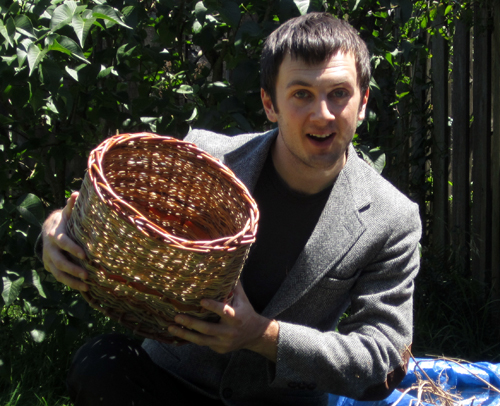English Ivy Basket #2

I’ve taken a few basket classes now, and of all the twining basketry books I think the two pictured above have the best information for newbies; great pictures and illustrations. So many books on basketry read like mathematic equations; lots and lots of strange vocabulary with no accompanying photographs or drawings. Even so, I think I may have a WAYK “technique: dictionary addiction” but with field guides and how-to manuals. I looked in the book once, instead of looking at a previously made basket, and it fucked me up.
I built this willow soaking pool and put my willows and English ivy in it. Of course, they immediately floated to the top. In order to fully moisten them for flexibility while making the basket, I needed to completely submerge them. I realized I needed a rather large rock to do so. I almost began to scour the neighborhood when I remembered, “Wait! I have a huge rock!” So I put the rock to good use.

After soaking these willows and ivy for almost a week I took them out and experimented a bit with their flexibility. Bending them back and forth and pressing on them with my thumbs. They seemed flexible enough.

First I built the base framework out of willows:


Then I stripped the ivy of its bark and used it to wrap the base frame together.

I realized that I could peel the ivy bark off and have it look much “cleaner” than with the dirty-looking bark left on. At first I scrapped the bark of the ivy off with my thumb nails. After about an hour of this I had only gone a few feet in length of ivy, and my thumb nails had started to pull off a bit and expose the nerve! Painful! So I stopped, painfully scrubbed my nails out and thought. I remembered this bark peeling thing I saw at the Ancient Arts Center a few months back when I took a basketry course there. It basically looked like two nails next to each other, and you just pull the willows through. I ran into my garage, hammered two nails to a board and voila! A bark peeler! It totally works! Take a little but more effort than simply pulling it through, but much nicer on my hands and way faster too!

The completed base:

Next I sharpened a whole bunch more willows and jammed them into the base, creating a new frame to bend upwards for the walls. I used a deer leg bone awl to open up the spaces that felt a little too tight for the sticks at first.



I put way too many warps in (because I looked in one of the books and not at my actual baskets!) and so I eventually had to remove about half of the ones in the pic above.
After peeling lots of bark and clipping lots of willows I realized this basketry disjecta will make great carbon for my nitrogen rich compost! (pssst thanks Lala)

The warps all tied up and ready to get wefted, yo:

The clean reed look of skinned ivy:

I played around a bit with using some cedar bark too. I haven’t tried that method of weft before, so I thought this would give me a chance to experiment.

The final product looks half decent. A few of the willows snapped even though they had soaked for a week (something the instructor at the Ancient Arts Center told me would happen with NW willows). The ivy worked better than I had thought. Next time I’d like to try leaving the bark on again, as I did with my English Ivy Bike Basket. Also, I’d like to try using only the ivy and no willows as I did with that one before. Mostly because if the native willows have more brittleness than I want, it just makes more sense to stick with the ivy. We’ll see!

Show your support and appreciation for Urban Scout


<3
half decent?! looks great… i cant wait to try one with your superstraightforward instructions.
and i will make sure to add basketry disjecta to my list of compostables!
Beautiful weaving basket there you made!
Thanks for sharing how to make one.
Do you have to clean the water out on daily basis while ivy/willow sticks are soaking?
Lala, Thanks! I didn’t leave very good instructions for the actual twinning process. It’s too complex to show in pictures and I wasn’t confident enough that it was the “right” method. Now I do know, so on the next one I will have better pics and instructions on how to wrap the wefts around the base and how to wrap the wefts around the basket. It’s kind of more tricky than you would think. And yeah, what a great source for carbon right!
RaVen, Thanks! I have left the water in there for a couple weeks now and it’s starting to look really dirty and the mosquitoes are a’brewin! So I need to drain it this week and start over. or at least come up with a flushing system. I’m gonna wait till a real hot day and water the plants early in the morning with it.
Nice lookin’ basket, Scout!
I read somewheres that traditional British basket makers boil the crap out of their willow (for a coupla hours). The California Miwok QUARTER theirs, lengthwise, which seems like a lot of work with just a piece of obsidian. Hope this helps,
D
Beautiful photos Scout!
Awesome job on your basketry!
Thank you for sharing 🙂
I told my roommate about the english ivy bike basket you made and she keeps mentioning it. This is awesome peter!
awesome